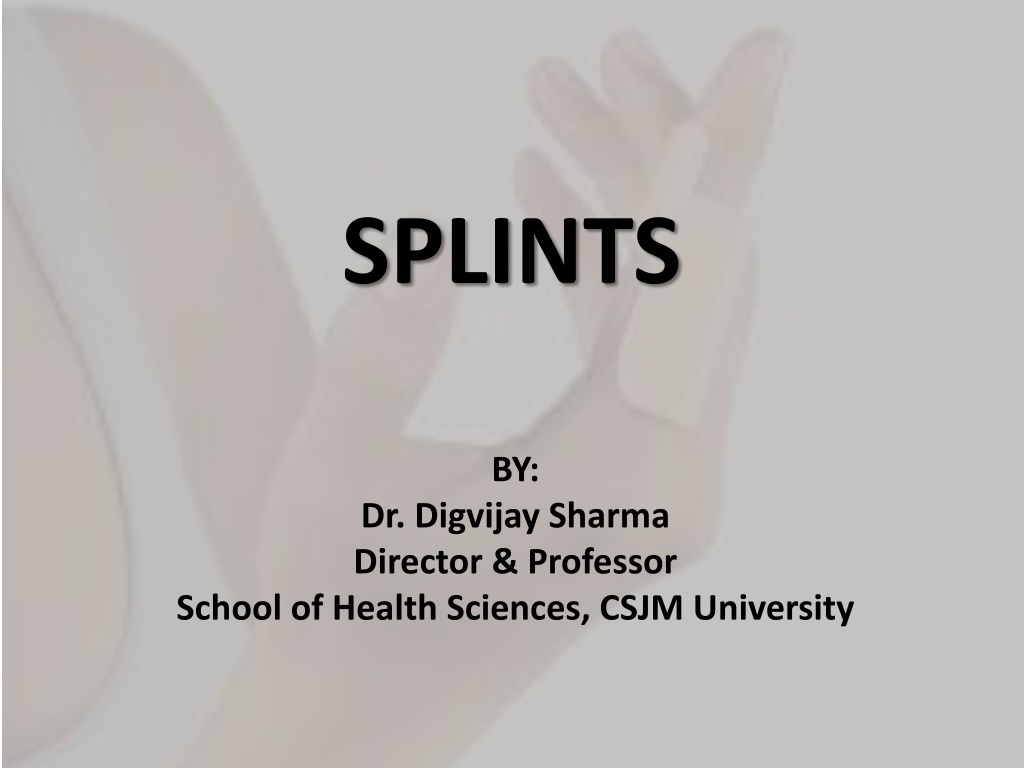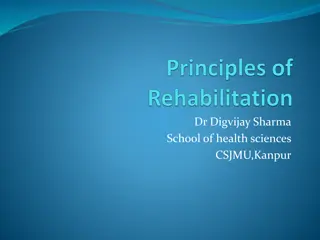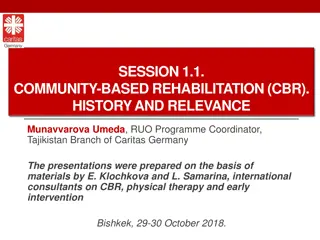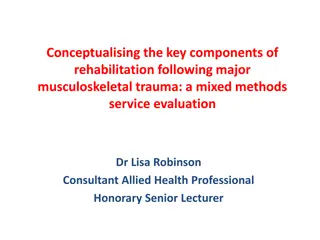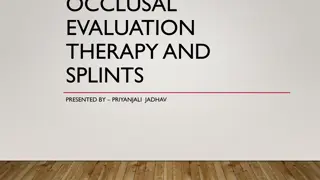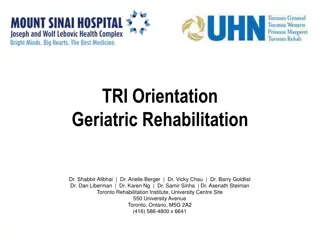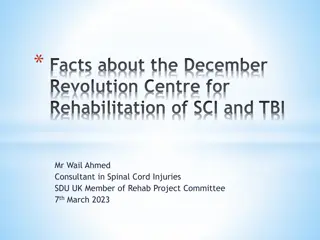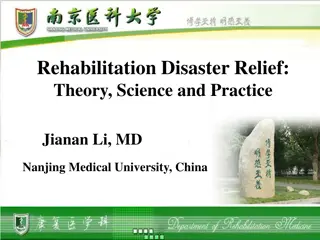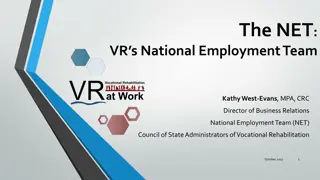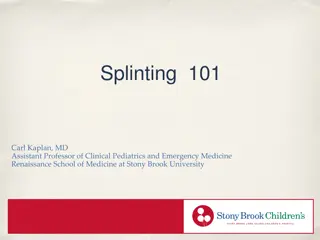Understanding Splints: Types, Functions, and Applications in Rehabilitation
Splints are essential devices used for stabilizing and supporting injured body parts, primarily in the upper extremities. They help maintain structural integrity, prevent unwanted movements, reduce pain, and promote rehabilitation through various types, including static and dynamic splints. Aeroplane splint is a specific type that aids in shoulder abduction and external rotation, commonly used in conditions like Erb's palsy and tendon ruptures.
Download Presentation

Please find below an Image/Link to download the presentation.
The content on the website is provided AS IS for your information and personal use only. It may not be sold, licensed, or shared on other websites without obtaining consent from the author. Download presentation by click this link. If you encounter any issues during the download, it is possible that the publisher has removed the file from their server.
E N D
Presentation Transcript
SPLINTS BY: Dr. Digvijay Sharma Director & Professor School of Health Sciences, CSJM University
Contents Introduction to Splints Functions of Splints Types of Splints Various splints
Introduction Splints are the technical and temporary devices that are used to provide assistance to an injured body part. These are most applied at the upper extremity. Earlier these splints were only used to stabilize the structures and thus were used efficiently in cases of fractures and other acute traumas. These days there are variety of splints which movement along function of stabilization. commonly also allow the with
Functions Maintain the structure in functional position Prevention of Undesirable movements Provide stability and support Reduce pain Maintains a position which is reduced by physiotherap y treatment Reduce muscle spasm Strengthen musculature Promote grip and pinch
Types of Splints Static Splints Dynamic Splints These are immobile. Prevent motion across a joint. Used to provide stability to the injured part. Used to contractures, used to align the structures whether reduced or not. Must only be applied to the joint being treated. Should be removed immediately after serving the purpose. Its disadvantage include the development of atrophy and muscle stiffness in various cases. These are mobile in nature. They not only provide support but also provide, control and strengthen the movements. The power of movement can be intrinsically triggered or through other body part or by electrical stimulation of patient s muscles. Extrinsically the power of movement comes from the pulley system and harnesses tied with the splints. Used effectively to provide prehension along with static positioning of the part in functional position after its use. rest and stretch joint
Aeroplane Splint Maintains the shoulder in abduction and external rotation. Also known as Shoulder arm Orthosis or Shoulder- elbow- wrist- hand orthosis. Consists of chest, arm, forearm and wrist joint at almost right angles. Keeps the joint in optimal position. Sometimes it is highly inconvenient for patients to maintain belt at the torso. Modifications include Functional arm orthosis, Gun slinger, Deltoid aid, etc.
IGR AEROPLANE SPLINT GUN SLINGER AEROPLANE SPLINT DELTOID AID FUNCTIONAL ARM ORTHOSIS
Indications Erb s palsy Avulsion of greater tuberosity of humerus Deltoid paralysis Supraspinatus tendon rupture Tubercular arthritis of Shoulder joint Abduction # of neck of humerus
Cock-up Splint Also called Wrist- hand orthosis. Immobilizes dorsiflexion with dorsal support. Can be transformed dynamic splint. Allows full metacarpophalangeal flexion and function of the thumb. Can be worn anytime except for exercise and bath. Used extensively in cases of Wrist drop or Radial nerve Injury, hemiplegia, etc. the wrist in into carpometacarpal
Knuckle Bender Splint Stabilizes metacarpophalangeal joint in 90 degree flexion interphalangeal extension. It serves the basic function of immobilizing the fingers, support and stabilization to the wrist in extension, maintains transverse palmer arch and assists in prehension. This splint is a typical example of 3- point principle. Used extensively in cases of Median and ulnar nerve palsy or Total claw disease and Ulnar claw hand. the and in joint BUNNELL FINGER hand, Hansen s BUNNELL REVERSE FINGER BUNNELL KNUCKLE BENDER SPLINT
C- Splint Stabilizes the thumb in abduction and partial rotation second metacarpal and supports it. Stretches the first web space. Indications median nerve injury, contractures, etc. under the include burns,
Short Opponens Splint Maintains the thumb in abduction and partial rotation under second metacarpal. Wrist and fingers are set free. Also called Wrist hand Orthosis Indicated in cases like low median nerve injury and opponens transfer.
Long Opponens Splint Thumb is stabilized in abduction and partial rotation under second metacarpal additional support to the dorsal wrist in functional position. Wrist in 20-30 degree dorsiflexion, metacarpophalangeal joint in 0- 5 degrees flexion. Other fingers are set free Stabilizes the thumb Used extensively in cases of scaphoid fracture, bennet s fracture and de Quervains tenosynovitis. Also called wrist- hand- forearm orthosis or thumb spica. with
Clavicular Orthosis Also known as Shoulder Orthosis, Clavicular Harness or Figure of four harness. Used extensively in Clavicular fractures, shoulders, contractures, etc. Improves posture, range of motion, tissue healing and reduces pain. Inhibits clavicular movements and scapular protraction with no hindrance to movements of GH joint. TOS, rounded pectoral
Arm Slings Also called figure of 8 harness, orthopaedic sling, universal sling, glenohumeral support, hook hemiharness, etc. Used in cases of rotator cuff injuries, bicipital tendonitis, brachial plexus lesion, AC joint injury, hemiparesis with subluxation, scapular and humeral fractures. Prevents overstretching of GH musculature and ligaments. Reduces oedema by elevating the hand and forearm. Roylan Hemiharness sling supports humerus but allows movement at the elbow and forearm. Studies have shown that use of slings should be discouraged in patients with UMN lesions because it tends to increase the flexion synergy thus enhancing incidences of development of contractures. Roylan Hemiharness are however difficult to use in bulky patients.
Sugar Tong Splint Also called elbow- wrist- hand orthosis. Places the elbow in 90 degree of flexion forearm and wrist in neutral position. Used in CTDs of elbow, forearm fractures, nerve transposition, etc. Basically used to inhibit movements at the elbow joint and promote healing of the tissues. and ulnar
Ultraflex Splint Also called elbow orthosis or wrist elbow, turn buckle splint, dynasplint, pheonix wrist hinge, etc. Indicated in conditions like contracture, burns, fractures, scar lesions, polio, spinal cord injury, brachial plexus lesion, radial nerve injury, etc. Used to increase soft tissue for tissue elongation. This orthosis provides traction which breakdowns. Traction may also increase muscle tone. may cause skin
Ring Orthosis Also called finger orthosis, swan neck splint, pulley ring, Boutonniere splint, Murphy ring splint, etc. Indicated in conditions like swan neck deformity, arthritis, boutonniere deformity, etc. Blocks the hyperextension. Prevents hypermobilization, overstretching and deformity. Swan neck splint allows IP flexion and splint allows IP extension. MURPHY SWAN NECK SPLINT PIP or DIP DYNAMIC BOUTONNIERE SPLINT boutonniere's
